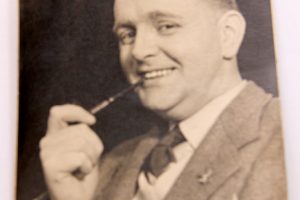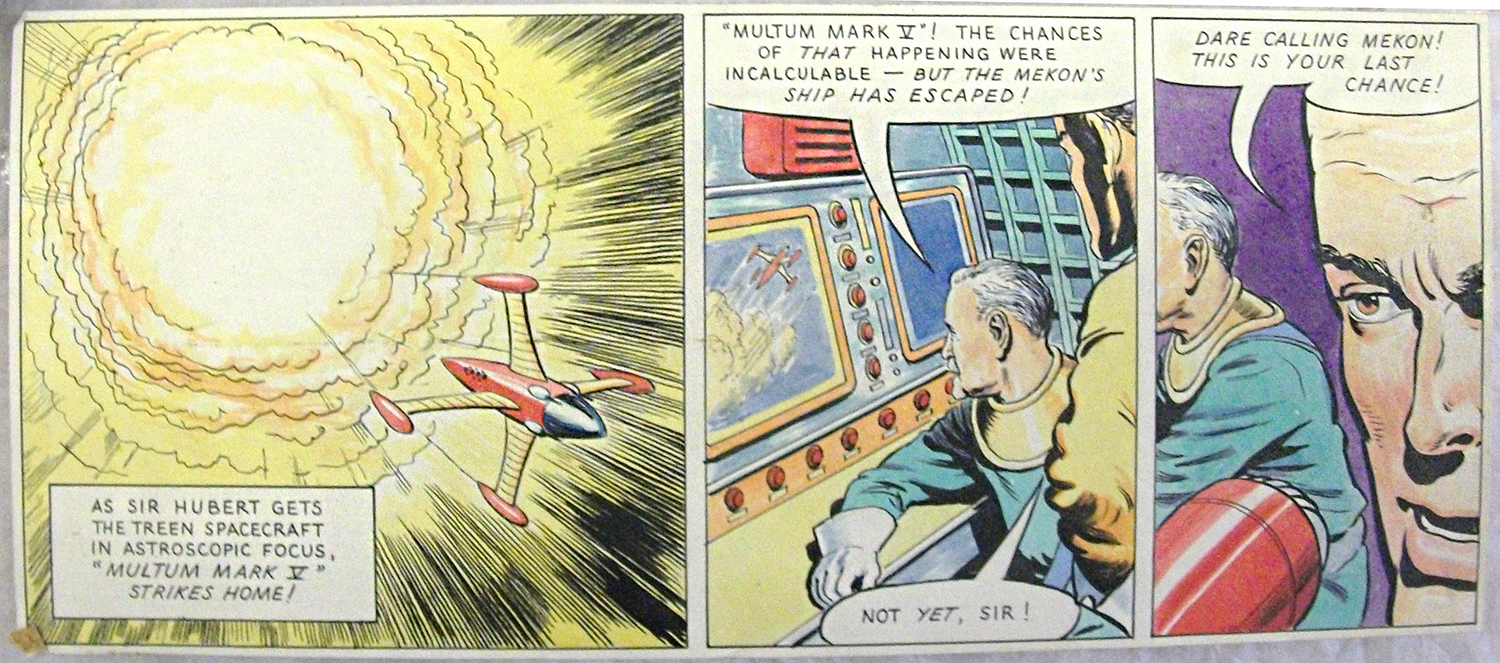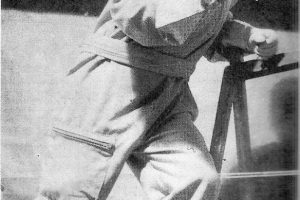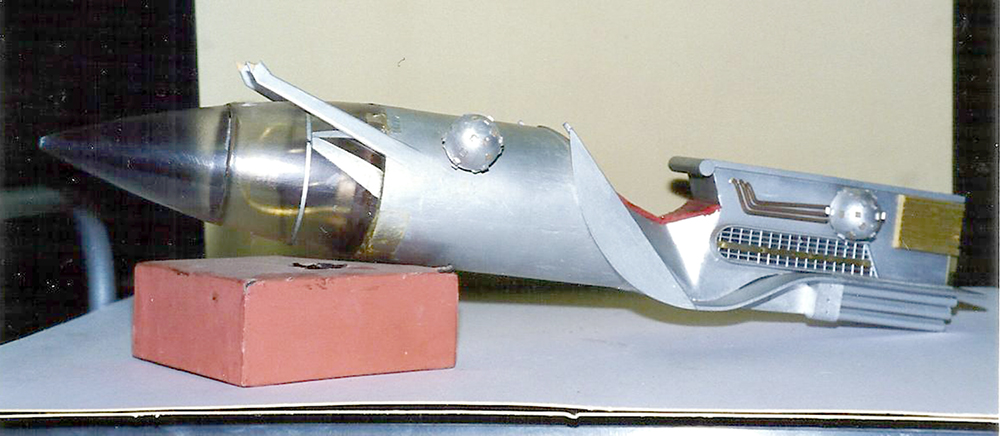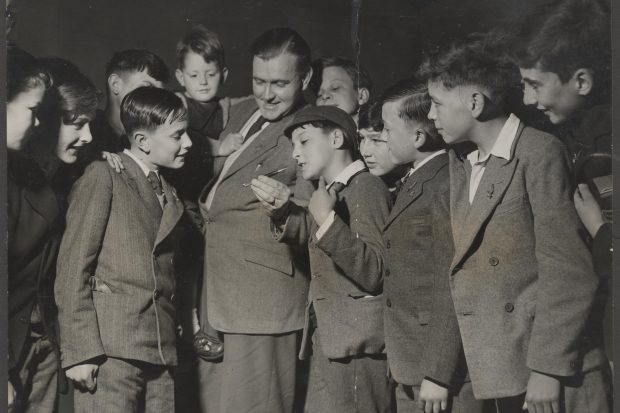This week’s #MyLocalMuseum theme is ‘Creative People’ and we are celebrating the man who drew Dan Dare, Frank Hampson.
Frank Hampson was born in December 1918 in Audenshaw near Manchester but the following March he and his family moved to Southport. He attended King George V Grammar School, left at 14 and started working in the Post Office. At 19 he began to study full time at The Victoria College of Arts & Science. He had enrolled on a design course there but in 1939 he was called up and joined the Royal Army Service Corp. He was rescued from Dunkirk in 1940. By 1944 he had been commissioned lieutenant of his unit and was landed in Normandy. That same year he married Dorothy Mable Jackson and at the end of the war returned safely to her in Southport.
- Frank Hampson
He became a member of the Southport School of Arts and Crafts and began working as an artist. During this time, he won a competition held by Southport Borough Council, by creating a poster to promote Southport as a seaside holiday destination. In 1947 he and Dorothy had their son, Peter. He also set up a silk-screen, colour-printing business with fellow student Harold Johns.
- Frank Hampson at his drawing board
The idea to produce a comic was that of local parish Vicar, at St James’ Birkdale, Marcus Morris. He wanted to depart from the violence he saw in comics, at the time, and impart the strip with Christian values. He and Frank began working together on this concept in 1949. Incredibly, early artwork survives of ‘Chaplain Dan Dare, the first parson in space’! However, by the time the first copies of the Eagle hit bookstalls in April 1950 the most popular strip was ‘Dan Dare, Pilot of the Future’. Hampson’s interest in space exploration came from his time in the army, it is thought that he had ambitions of joining the RAF and in 1953 wrote, “On the quays of Antwerp you could watch the birth of Space Travel”.
- Dan Dare Strip
Realising what a hit they had, Morris knew they must start employing more artists full time to cope with the workload. He hired Bruce Cornwell, Terry Maloney, Jocelyn Thomas and Eric Eden as well as making others, including Frank’s friend Harold Johns who had previously been working on another of Morris’ publications ‘Anvil’, part of the team. The unlikely office for this team was in a former bakery on Botanic Road, Churchtown. Known as ‘The Bakehouse Studio’ it was short on space, reportedly very cold and so was not beloved by the artists at the time. Nevertheless, it was the birthplace of many Dan Dare stories as well as several other strips running in the Eagle. An exploded drawing of the Bakehouse was produced by Graham Bleathman for Spaceship Away (a Dan Dare fanzine). Before long it became clear that larger premises were essential for the growing team and workload. It was decided to move the whole studio closer to their publishers in London. So, in 1951 the the entire studio team and three generations of the Hampson family moved to Epsom, in Surrey.
- The Bakehouse
The artistic prosses was full on, 24/7, particularly for Frank. His exacting eye and attention to detail were always recognisable in his work. He held a sense of duty to his readers, largely young boys, to get things right and often included labelled diagrams. In the early days when Frank was writing the stories himself, he would come up with the concept over the weekends and complete two ‘rough’ pages, drawn in high detail in pencils, sometimes not far from finished when he used inks. Then two days were devoted to the team posing, photographing and developing each scene, leaving only three days in which to create that week’s art. Each artist, including Frank, would then be allocated frames to produce the finished Dan Dare artwork, using the photographs and studio aids. Hampson would usually take the first page, as it would be the Eagle‘s cover.
- Dan Dare’s space suit
- Dan Dare’s space suit
Part of his meticulousness was his commitment to realism, and this is what lead to the practice of creating reference material to draw from. He had to have a prop in front of him or people who were dressed as various characters in the Dan Dare comic strip. Sometimes he would photograph them and work from that. Family members and studio artists alike were expected to model and pose for photographs and drawings in order to ensure the complete accuracy of each action frame. His son Peter modelled for Cadet Flamer Spry, Greta Tomlinson was Miss Peabody. One of the early images we have acquired from the Peter Hampson collection is a drawing from 1947, of Frank’s father, who became the model for Sir Hubert Guest, Controller of Space Fleet. We even think that the original character design for Dan Dare was based on Frank himself! Later models and busts of the main characters were produced.
- Miss Peabody
- The Mekon
The Atkinson holds several originals and recreations of the props he would work from. At first, they were all home-made in Blue Peter style with cartons and bottles stuck together and then spray painted. We have three good prototypes of the space craft that appear in the various strips, a ray gun and the uniforms they wore. A lot of the uniforms were created from army surplus and heavily customised to fit the characters, attaching specially embroidered badges with the Space Corps insignia on them. In the final studio in Epsom, Bayford Lodge, Frank had a floor take out to allow him to take reference photographs from way above where his colleagues were posing to create his signature vertiginous angles.
- Eagle Lero
- Dan Dare
- Mekon
- Dan Dare space ship
This video is from 1956 and was filmed in the Bayford Lodge studio in Epsom. You can see some of the props now held here at The Atkinson.
Frank left Eagle in April 1961 after much of his original team had already moved on. He began to take small advertising commissions in cartoon strip style. He also moved to creating illustrations for Ladybird books aimed at young readers, illustrating eleven in total. He spent time working as a graphics technician at Ewell Technical College. He when on to study Art History with the Open University and he graduated early in 1979.
- The Battle of Hastings, Ladybird illustration
In 1975 Hampson was voted Prestigioso Maestro at an international convention of strip cartoon and animated film. A jury of his peers also gave him a Yellow Kid Award and declared him to be the best writer and artist of strip cartoons since the end of the Second World War. In 1976 Frank was presented with a special Ally Sloper award by the British Association of Comics Enthusiasts to commemorate his major contribution to the art of cartoon strips. Frank Hampson died in July 1985, in Epsom, Surrey, He has two plaques dedicated to him, one at his birthplace in Audenshaw and another on Bayford Lodge in Epsom. He still has thousands of fans and is regarded worldwide as a legend of the comic art form to this day.
- Frank Hampson with young fans
Find out more in our local history museum, Between Land & Sea, and discover the stories of the people who have lived and worked along the Sefton coast.
Written by Jenny Cope, Museum Futures Trainee
Posted on 30 March 2021 under General news, Museum





